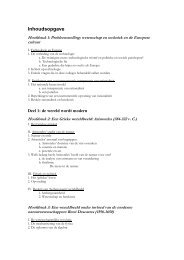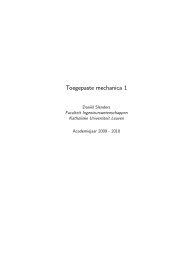Algemene en technische scheikunde
Algemene en technische scheikunde
Algemene en technische scheikunde
Create successful ePaper yourself
Turn your PDF publications into a flip-book with our unique Google optimized e-Paper software.
En voor de tweede stof:<br />
m = n ∗ M<br />
9.3 g = 0.15 ∗ (a + 2 ∗ z) mol ∗ g<br />
mol<br />
0.15 ∗ a + 0.3 ∗ z = 9.3<br />
Dit geeft dus het volg<strong>en</strong>de stelsel:<br />
<br />
0.3 ∗ a + 0.45 ∗ z = 15.9<br />
0.15 ∗ a + 0.3 ∗ z = 9.3<br />
Als we de tweede vergelijking twee keer van de eerste aftrekk<strong>en</strong>, geeft dat:<br />
0.3 ∗ a + 0.45 ∗ z − 2 ∗ (0.15 ∗ a + 0.3 ∗ z) = 15.9 − 2 ∗ 9.3<br />
−0.15 ∗ z = −2.7<br />
z = 18<br />
Stof Z heeft dus e<strong>en</strong> molaire massa van 18 g/mol. De molaire massa van stof A wordt dan:<br />
0.3 ∗ a + 0.45 ∗ z = 15.9<br />
0.3 ∗ a + 0.45 ∗ 18 = 15.9<br />
Stof A heeft dus e<strong>en</strong> molaire massa van 26 g/mol.<br />
Oef<strong>en</strong>ing 5<br />
Vraag<br />
a = 26<br />
A piece of nickel foil, 0.550 mm thick and with a square surface with a side of 1.25 cm, is<br />
allowed to <strong>en</strong>tirely react with fluorine, F2, to give a nickel fluoride.<br />
1. How many moles of nickel foil were used? (The d<strong>en</strong>sity of nickel is 8.908 g/cm 3 .)<br />
2. If you obtain 1.261 g of the nickel fluoride, what is the empirical formula?<br />
Oplossing - 1<br />
Het aantal mol nikkel kunn<strong>en</strong> we uit het volume, de massadichtheid <strong>en</strong> de molaire massa hal<strong>en</strong>:<br />
n = m<br />
M<br />
ρ ∗ V<br />
n =<br />
58.96 g/mol<br />
8.908 ∗ 0.055 ∗ 1.252 g/cm<br />
n =<br />
58.96<br />
3 ∗ cm3 g/mol<br />
n = 0.0130 mol<br />
(29)<br />
(30)<br />
(31)<br />
(32)<br />
(33)<br />
14





